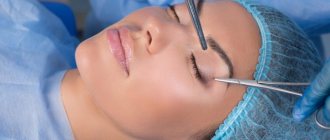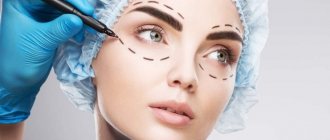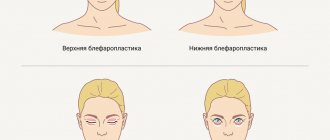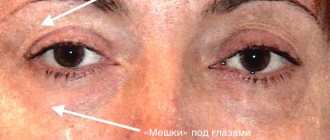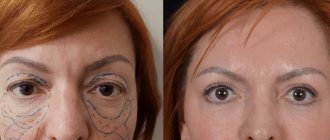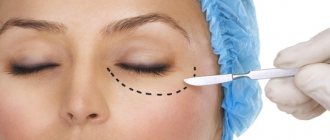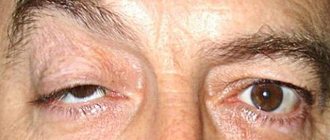The skin around the eyes is most susceptible to age-related changes in the face. Therefore, blepharoplasty, or eyelid surgery, has become the most popular plastic surgery in the facial area. This procedure is performed on patients with wrinkles on the upper or lower eyelids, bags under the eyes, and also to eliminate the effect of sagging upper eyelids.
Not so long ago, it was possible to get rid of congenital pathology of the eyelids or eliminate age-related changes only with the help of surgical intervention, but the development of hardware technologies in cosmetology has made it possible to correct eyelids without extensive surgery - today two non-surgical blepharoplasty procedures are available, which are an alternative to plastic surgery:
- Laser blepharoplasty using fractional CO2 laser SmartХide DOT;
- SMAS eyelid lifting using the Ultraformer 3 device.
Laser blepharoplasty
Laser blepharoplasty (Laser eyelid resurfacing) is a procedure that allows, without a scalpel or incisions, to reduce the skin of the upper and lower eyelids using laser action, as well as eliminate wrinkles around the eyes.
Today, this is a worthy alternative to surgical intervention, which has a number of undeniable advantages.
The procedure is performed using a fractional CO2 laser SmartХide DOT (Italy). This is a unique CO2 laser platform with an integrated innovative DOT Therapy® technique, which is absolutely deservedly the gold standard in the field of laser facial rejuvenation.
Contraindications
Laser blepharoplasty is a minimally invasive operation that is considered quite simple and safe. But like any other surgical intervention, eyelid correction with a laser has certain contraindications:
- anemia;
- blood clotting disorder;
- exacerbation of any somatic diseases and infectious processes;
- disorders of the thymus gland;
- oncological diseases;
- ophthalmological diseases in the acute stage;
- increased intracranial pressure, uncontrolled arterial hypertension.
Contraindications to laser blepharoplasty are identified by an ophthalmologist at the stage of examination and comprehensive diagnostics.
Relative contraindications include the following:
- inflammatory processes of the skin of the eyelids;
- viral diseases;
- recent surgery.
Some diseases require more careful preparation. Diabetes mellitus is a conditional contraindication. But when blood glucose is normalized, experts give permission to perform laser blepharoplasty.
Features of the laser resurfacing procedure
The laser beam, penetrating deep into the skin, is divided into many microbeams, which create pinpoint microscopic damage in the skin. In areas of damage, intensive recovery processes are launched, since the ability of skin tissue to regenerate is very high. The targeted effect provides a sufficient supply of healthy cells (that have not been exposed to micro-rays), which serve as a source for the creation of new collagen and elastin. At the same time, the skin significantly contracts and tightens - pinpoint areas of damage “evaporate” micro areas of the skin. Due to these processes, the skin of the eyelids is tightened and wrinkles around the eyes are smoothed out.
Preparing for surgery
Preparation for blepharoplasty begins with a consultation with an ophthalmologist. The specialist carefully listens to the patients’ complaints, conducts an initial examination, and studies the medical history.
The next stage of preparation is taking traditional tests:
- general blood and urine analysis;
- blood biochemistry;
- determining the amount of glucose in the blood;
- analysis for HIV, hepatitis B and C, and other infections;
- determination of blood group and Rh factor.
After receiving the results of a comprehensive diagnosis, the specialist receives detailed information about the patient’s health status. This allows you to decide on the further technique of the operation or postpone surgical intervention for a certain period.
Features of the SMAS lifting procedure
The Ultroformer 3 device uses HIFU (High intensity focused ultrasound) technology - high-intensity focused ultrasound penetrates several levels of the skin and reaches the muscular aponeurotic layer (SMAS). Under the influence of ultrasonic waves, the temperature of soft tissues at a microthermal point at a given depth increases to 60–70°C.
Directed radiation triggers the processes of contraction and compaction of SMAS, tissue repair, lipolysis, and also activates collagen production. Thermal damage stimulates the synthesis of a new collagen matrix, the renewal of which is completed in 3–4 months.
What types of eyelid surgery are performed in our clinic?
Upper blepharoplasty.
During the operation, the upper eyelids are affected: their overhang is removed by excision of excess skin and fatty tissue.
Lower blepharoplasty.
The correction is aimed at eliminating wrinkles and fatty hernias under the eyes, pronounced nasolacrimal grooves.
Circular.
The surgeon works with both the upper and lower eyelids - all imperfections and age-related changes are eliminated, excess skin and subcutaneous fat are excised.
Transconjunctival.
In this case, the operation is performed through a closed approach: an incision is made along the conjunctiva “from the inside” of the eye. In this way, only fatty hernias that form bags under the eyes are removed; an experienced surgeon can also redistribute the fatty tissue in order to correct the nasolacrimal groove.
Canthopexy.
The operation involves lifting the outer corners of the eyes through tightening the lateral ligaments. Simple manipulations allow you to fix the lower eyelids in a new position - without sagging.
Canthoplasty.
It is carried out in cases where it is necessary to change the shape of the eyes and lengthen them.
Laser eyelid surgery.
A laser is used to make the incisions, which makes the procedure bloodless, sterile, reduces recovery time and guarantees no scars.
Rehabilitation
After laser blepharoplasty, discomfort, swelling and redness that occur after the procedure disappear spontaneously within 2-3 days, depending on the type of laser and the power of the parameters chosen by the doctor. The swelling goes away completely after 7–10 days. In the first days after grinding, crusts form that cannot be damaged mechanically. They will go away within 5-7 days.
After SMAS eyelid lifting, immediately after the procedure, redness of the area that was exposed (from 20 to 60 minutes), limited swelling (3-5 days) may be noted. All these reactions pass quickly and do not require a recovery period.
Reviews from doctors
Anna Gennadievna, surgeon: Laser blepharoplasty is safe. For serious indications, more than 5 procedures are required in combination with other methods. After surgery, it is important to follow the specialist’s recommendations. Do not hesitate to ask and contact us if unwanted effects occur. Sometimes there is dry eye syndrome, severe swelling of the eyelids and pain. These conditions require the use of special medications.
Alina Viktorovna, cosmetologist: Laser eyelid lifting is recommended if other safe cosmetic methods are ineffective. During blepharoplasty, special attention should be paid to protecting the skin around the eyes from ultraviolet rays and injury. For a lasting result, you will need not one, but at least 3-5 procedures.
Sergey Vladimirovich, surgeon: Often it is necessary to correct complications after blepharoplasty performed by dubious specialists and in non-specialized institutions. The procedure itself is painless, safe, complications rarely arise if the doctor is sufficiently qualified and the patient follows the recommendations in the postoperative period.
Result
After laser blepharoplasty, the first visible effect of the procedure appears after the rehabilitation period, on average 5–7 days. At the same time, the skin noticeably tightens, becomes elastic, not only small but also deep wrinkles, scars and stretch marks disappear or are significantly reduced. The effect is increasing, most pronounced 2-3 months after the procedure.
After SMAS eyelid lifting, the first results of the procedure are noticeable immediately, the maximum effect is achieved after 3-4 months. It is recommended to repeat the procedure once a year.
Blepharoplasty of eyelids - before and after
In the photo: Blepharoplasty of the upper eyelids before and after
Circular blepharoplasty, The result is presented 1 week after surgery
In the photo: Blepharoplasty of the upper eyelids, 3/4 view
See more photos before and after eyelid blepharoplasty in the photo gallery
How does the laser method differ from the surgical method?
During blepharoplasty , a scalpel is used .
Know! Laser blepharoplasty is performed using a medical laser and, unlike a surgical procedure, produces less noticeable scars.
If during surgery severe hemorrhages can occur due to damage to blood vessels and capillaries, then during laser surgery the damaged vessels are immediately cauterized with a laser beam.
Therefore, such consequences can be avoided.
The laser used during surgery serves not only to excise tissue.
It performs several functions, including creating microscopic burns , which prevent the entry of pathogenic microorganisms and reduce the risk of secondary infection.
Why blepharoplasty should be done in our clinic
- The surgeon develops a surgical plan individually and offers the patient the most optimal option. In this case, the peculiarities of the condition of the skin of the eyelids, anthropometry and all the wishes of the patient himself are taken into account.
- Anesthesia is selected by an experienced anesthesiologist in accordance with the complexity of the intervention and general medical history. We use the most modern drugs, without side effects.
- Provided all recommendations are followed, complications and unpleasant surprises are excluded.
- The clinic’s equipment and the experience of its specialists allow us to successfully carry out corrections of any complexity.
- The surgeon must observe the patient after the operation. If necessary, you can contact him at any time of the day!
- The result is always predictable. But often our patients say that they did not expect... such a great result.
How is the operation performed?
The operation lasts relatively short time - usually from half an hour to an hour. Most often, our anesthesiologists use intravenous anesthesia or general anesthesia. With minor corrections, local anesthesia is possible.
Upper blepharoplasty begins with an incision along the natural crease. The amount of skin tissue and subcutaneous fat to be removed is determined on an individual basis. It is important here not to leave excess or create excessive tension on the skin. The orbital orbicularis muscles may also be involved at the surgeon's discretion.
Lower blepharoplasty is performed through an open or closed approach. If it is necessary to excise excess skin, the incision is made from the outside, and if it is only necessary to remove fatty hernias and the skin has good elasticity, the surgeon “selects” through the conjunctiva. Sometimes it becomes advisable to redistribute subcutaneous fat (Loeb operation).
Benefits of laser eye rejuvenation
- A noticeable rejuvenating effect not only of the periorbital zone, but also of the entire upper third of the face, which appears after a month and continues to increase over time.
- Short recovery period (2 - 3 days).
- No pain due to local anesthesia.
- Low cost compared to surgery.
Preparation for the procedure
Before the procedure, a preliminary free consultation with a doctor at our clinic is held. The specialist examines the area of future treatment, determines the presence or absence of contraindications, introduces the patient to the features of the laser rejuvenation technique for the eyelids and area under the eyes, and patient reviews with photos before and after the procedure help make the final choice.
Immediately before the procedure, it is not recommended to expose the skin to the sun.
Indications for laser rejuvenation of the eye area
- Bags, swelling, small hernias, dark circles in the eye area.
- Hyperpigmentation in the periorbital area.
- Capillary network around the eyes.
- Scars and other skin defects.
- Withering, wrinkles and other signs of aging of the skin around the eyes.
- Drooping of the upper eyelid.
Contraindications to the procedure
- Symptoms of a viral infection.
- Inflammatory processes in the treatment area.
- Bronchial asthma (except for mild severity).
- Systemic autoimmune diseases.
- Malignant tumor processes.
Stages of the procedure
Before laser treatment, 1 drop is instilled into the eyes. Alcaine anesthetic solution and special protective caps made of medical steel, pre-lubricated with Solcoseryl ointment, are put on the eyeballs. Such measures ensure complete safety and painlessness of the procedure.
Laser blepharoplasty takes place in 4 or 5 stages:
- At the first stage, laser treatment of the inner surface of the eyelids (conjunctival mucosa) is performed with a fractional beam of an ER: YAG laser in the Smooth FOTONA mode (a unique patented Fotona technique)
- At the second stage, the skin surface is treated with a neodymium laser ND:YAG FOTONA in order to affect the mid-dermis structures and the vascular component in Frac 3 mode.
- At the third stage, the tissues of the periorbital region and the middle zone of the face are uniformly heated with an ND:YAG laser in Piano mode.
- At the final stage, the skin is exposed to an erbium laser in Smooth mode - an ultra-long pulse to stimulate neocollagenesis and tissue tightening.
- An additional fifth stage - fractional laser resurfacing - is carried out in case of pronounced excess skin of the upper eyelid and its overhang.
What happens after laser treatment?
During the rehabilitation period (first 48 hours), the patient may feel a slight tingling sensation in the treatment area. Some swelling may also occur. These phenomena disappear within two to three days. According to patient reviews, a noticeable effect of skin rejuvenation in the area around the eyes occurs 3-4 weeks after one laser procedure and further intensifies within another month.
IMPORTANT! To obtain a stable and long-lasting anti-aging result, a course of three procedures is recommended with a frequency of 40-60 days.
Results of laser eye rejuvenation procedure
- The deep layers of the dermis are reconstructed.
- The production of new collagen is stimulated in all layers of the skin of the eyelids and the area around the eyes.
- The stratum corneum of the epidermis is removed, which leads to skin lightening and elimination of age spots.
- The tone and turgor of tissues are restored.
- Small wrinkles are completely smoothed out and large ones are significantly reduced.
- The sagging of the upper eyelid is eliminated.
- After 4D laser rejuvenation of the midface, it looks fresher and more attractive.
Frequently asked questions about laser eye rejuvenation
How long does this procedure take? On average about 1 hour. Is it possible to combine laser eye rejuvenation and Botox injections? It's not worth combining. To enhance and prolong the effect, it is recommended to combine the laser rejuvenation procedure for the area around the eyes, for the upper and lower eyelids with biorevitalization with hyaluronic acid or bioreparation of this area. And the question of administering botulinum toxin type A drugs - Botox, Dysport, etc. (if necessary) should be postponed for at least 2-3 months after the procedure. At what time of year can laser eyelid rejuvenation be performed? Anytime. The procedure has no seasonal restrictions.

